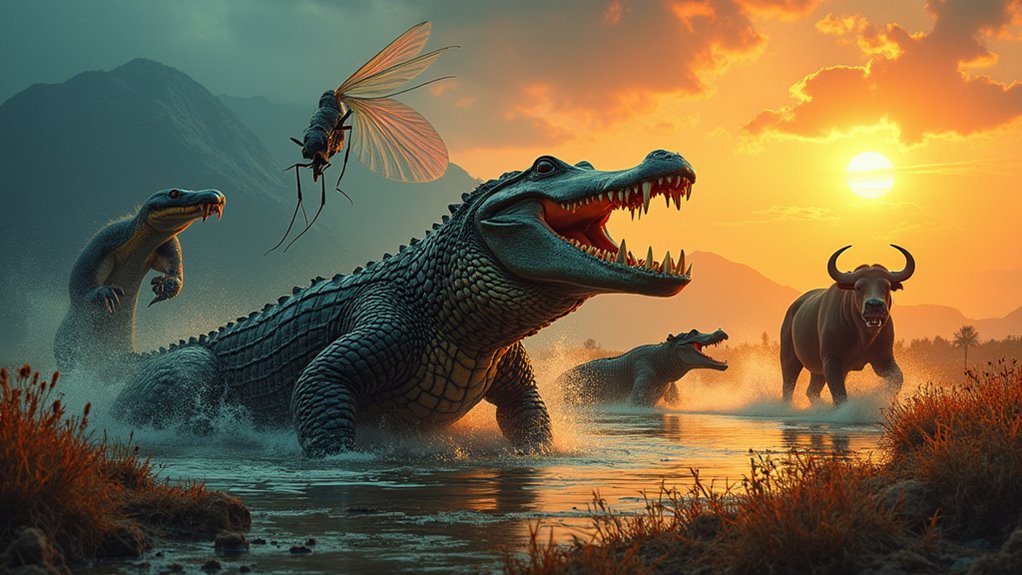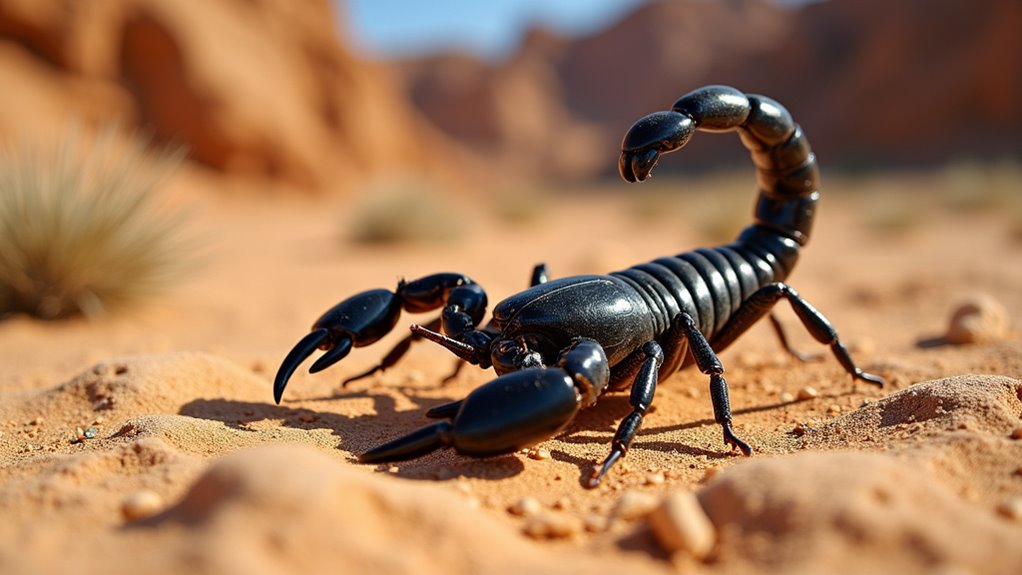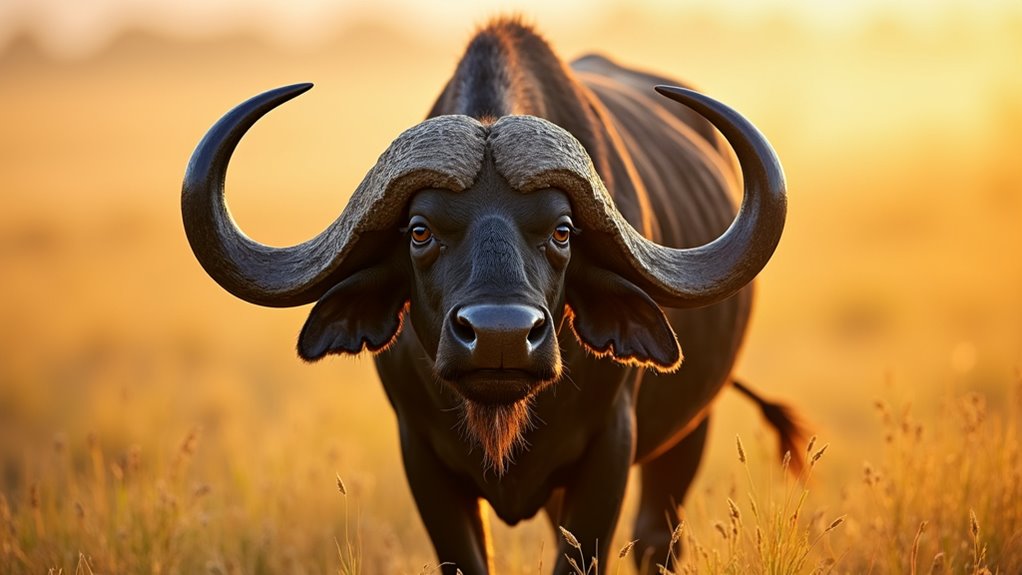Physical Address
304 North Cardinal St.
Dorchester Center, MA 02124
Physical Address
304 North Cardinal St.
Dorchester Center, MA 02124

A frightening collection of nature's deadliest killers proves small creatures can be lethal, while some giants are more dangerous than you'd expect.
The world’s deadliest animals aren’t always the most obvious threats. Mosquitoes top the list, causing nearly a million deaths yearly through disease transmission. Other lethal creatures include saltwater crocodiles, hippos, venomous snakes, elephants, cape buffalo, tapeworms, and bull sharks. While large predators appear intimidating, it’s often the smaller or seemingly docile animals that pose the greatest danger. Discover what makes each of these species so deadly and how to avoid becoming their next victim.

When it comes to deadly creatures, appearances can be deceiving. While sharks often grab headlines, they’re responsible for only about 6 deaths annually—far fewer than the humble hippopotamus, which kills around 500 people each year.
Nature’s deadliest aren’t always its most feared—hippos claim 500 lives yearly while sharks take just 6.
The deadliest animals aren’t always the most intimidating. Crocodiles top the list with approximately 1,000 human fatalities annually, followed by hippopotamuses and elephants tied at 500 deaths each. However, mosquitoes cause the highest human death toll by transmitting deadly disease vectors rather than through direct attacks.
Surprisingly, tapeworms claim about 700 lives yearly, making these tiny parasites more deadly than lions, which cause between 100-250 deaths.
You’ll find these dangerous animals across specific regions—hippos in sub-Saharan Africa, saltwater crocodiles in Southeast Asia and Australia, and elephants throughout Africa and parts of Asia. Their territorial nature and immense power make human encounters particularly risky.

While crocodiles and hippos may be impressive killers, they pale in comparison to an adversary so small you mightn’t even notice it. Mosquitoes claim between 725,000 and 1 million human lives annually, making them the planet’s deadliest creature.
These tiny assassins achieve their lethal status by transmitting devastating diseases like malaria, dengue, yellow fever, and Zika. With over 3,700 species worldwide, mosquitoes have mastered the art of spreading illness. Climate change has led to an eight-fold increase in dengue cases since 2000, expanding mosquito territories into new regions.
Malaria alone causes 600,000 deaths yearly, while dengue affects up to 400 million people.
The most dangerous species include Anopheles (malaria), Aedes aegypti (dengue, Zika), and Culex (Japanese encephalitis). Their impact extends beyond health to severe economic and ecological consequences, making mosquito control efforts critical worldwide.

What makes saltwater crocodiles one of nature’s most formidable predators? These massive reptiles, reaching over 23 feet and weighing more than 2,200 pounds, are the largest reptiles on Earth. They’re perfectly adapted for ambush attacks with their powerful tails and V-shaped snouts.
You’ll find these dangerous creatures throughout the Indo-Pacific region, from India to Australia, often lurking in mangroves and brackish waters. With a remarkable lifespan of up to 70 years, they remain dangerous predators for decades.
They’re particularly concerning because:
Despite being globally listed as “Least Concern,” many local populations face threats from habitat loss and human conflict.

While saltwater crocodiles dominate coastal regions with their ambush tactics, hippopotamuses reign as Africa’s deadliest large animals, causing far more human fatalities yearly. These territorial herbivores kill approximately 500 people annually across sub-Saharan Africa, primarily attacking local farmers and residents.
Don’t be fooled by their plant-based diet – hippos are fiercely territorial, especially when humans encroach on their freshwater habitats. Most attacks occur in or near water, but they’ll also raid crops on land. Their powerful jaws inflict crushing injuries that often lead to severe infections from bacteria in their saliva. They can easily crush objects with their enormous incisors that become visible when they open their mouths up to 150 degrees.
Despite their dangerous reputation, hippos play a vital ecological role through nutrient cycling. Their dung enriches aquatic ecosystems, supporting biodiversity while they shape their environment as natural ecosystem engineers.

Across the globe, venomous snakes silently claim thousands of human lives annually, establishing themselves among nature’s deadliest predators. While the inland taipan possesses the most toxic venom on earth, it’s the saw-scaled viper that causes the most human fatalities due to its aggression and proximity to populated areas.
What makes these reptiles so dangerous:

Beyond the dangers lurking on land, Earth’s oceans harbor an equally lethal predator – the box jellyfish. These transparent, cube-shaped creatures can kill an adult human in under five minutes, making them among the world’s deadliest animals.
When you encounter a box jellyfish, its nematocysts explosively discharge venomous tubules into your skin upon contact. You’ll experience excruciating pain that rapidly progresses to potential cardiac arrest.
Their venom contains complex proteins that attack cell membranes and potentially your heart directly. Remarkably, scientists have identified over 170 toxin proteins in box jellyfish venom, making it extraordinarily complex and difficult to treat.
If stung, don’t rub the area. Apply vinegar to neutralize undischarged nematocysts and seek immediate medical attention.
These silent killers inhabit tropical waters worldwide, especially near Australian and Caribbean beaches, and are most prevalent during warmer months.

Lurking in deserts and arid landscapes around the world, scorpions represent nature’s perfect ambush predators with their deadly venom and specialized hunting tools. While over 2,500 species exist, only about 30 pose serious danger to humans.
These solitary hunters emerge at night, using their acute sense of touch to locate prey before delivering a paralyzing sting. Their complex venom contains neurotoxins that can be lethal, especially to children and vulnerable individuals. Scorpion toxins work by selectively binding to voltage-gated ion channels, disrupting normal nervous system function in victims.
Deadly nocturnal predators that rely on touch to hunt, scorpions deliver potent venom that poses special danger to society’s most vulnerable.
If you’re traveling in scorpion territory, remember:
Despite their fearsome reputation, scorpions serve important ecological roles by controlling insect populations in their habitats.

Elephants stand as nature’s most magnificent land mammals, combining breathtaking power with surprising gentleness. Despite their typically peaceful nature, these intelligent creatures can become dangerously unpredictable under certain conditions.
When male elephants enter musth—a period of heightened testosterone—their aggression spikes dramatically. You’ll want to be especially cautious around isolated males, as they’re more prone to fear-based aggression without the social structure that normally regulates their behavior. Research shows that the presence of older bulls significantly reduces aggressive behaviors in younger males.
Environmental threats, health issues, and social disruption can transform these gentle giants into lethal forces. If you encounter an elephant displaying warning signs like ear-spreading, head-shaking, or mock charges, keep your distance immediately.
Their defensive behaviors can quickly escalate to deadly attacks, particularly when they’re protecting young or feeling threatened.

Standing among Africa’s most feared animals, the Cape buffalo deserves its reputation as one of the continent’s deadliest mammals despite being a herbivore. These massive bovids, weighing up to 1,000 kg, inhabit various African ecosystems from dense forests to semi-arid bushlands, always staying within 20 km of water sources.
When you encounter Cape buffalo in the wild, remember these vital facts:
Their unpredictable nature and defensive aggression make them responsible for numerous human fatalities annually. The buffalo’s dangerous reputation is reflected in its hunting statistics, where it reportedly causes more deaths in Africa than any other animal, with wounded buffaloes often ambushing pursuers in vegetation.

While Cape buffaloes present a visible threat in the African landscape, not all dangerous creatures announce their presence so boldly. Tapeworms silently invade your body through undercooked meat, establishing themselves in your intestines where they feed on nutrients meant for you.
Nature’s threats operate on a spectrum of visibility—from charging buffaloes to microscopic parasites silently stealing your nutrients.
Species like Taenia solium (pork tapeworm) pose particularly serious risks. If their eggs enter your system, they can develop into cysticercosis, with cysts potentially forming in your brain—a condition called neurocysticercosis that causes severe neurological problems. The adult tapeworm can reach over 15 meters in length while residing in the human intestine.
These parasites exist worldwide but flourish where food safety practices are lacking. Proper cooking, good hygiene, and thorough meat inspection remain your best defenses.
Treatment typically involves antiparasitic medications, though surgical intervention may be necessary for advanced cases.

The bull shark stands among the ocean’s most formidable predators, uniquely adapted to hunt in both saltwater and freshwater environments. With their short, broad snouts and powerful bite force, these territorial hunters are responsible for 119 reported attacks, including 26 fatal unprovoked incidents.
What makes bull sharks particularly dangerous:
You’ve now seen why these 11 creatures earn their dangerous reputations. Despite their fearsome nature, your chances of encountering most are slim. Consider this: mosquitoes alone kill over 700,000 people annually—that’s equivalent to wiping out a city the size of Denver each year. When traveling or exploring unfamiliar environments, stay informed about local wildlife and follow safety guidelines to minimize your risk of dangerous encounters.